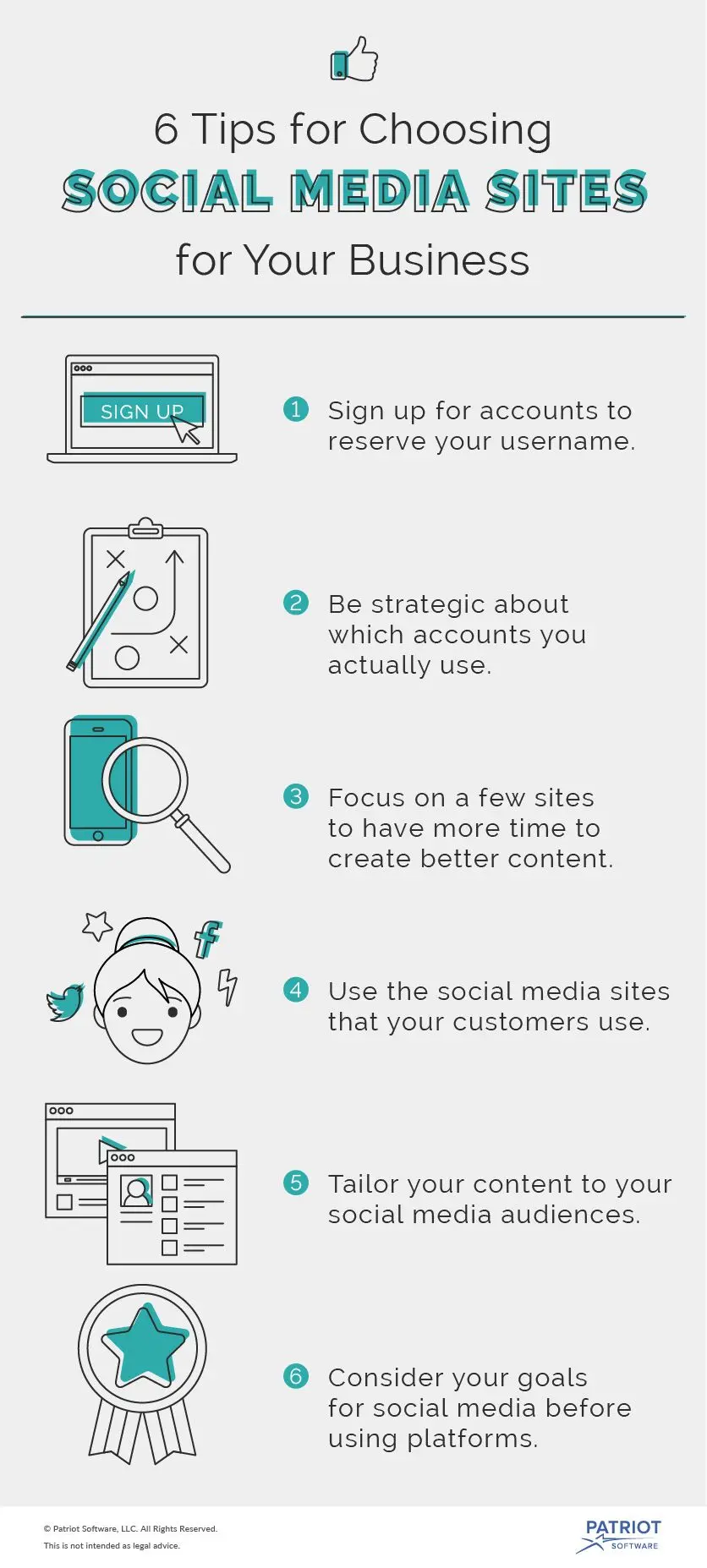Social media is a great way to market your business. You can announce news and engage with customers through social media. Best of all, social media tends to be a low-cost way to market your business.
Which social media platform is right for your business? There are so many available that it can be difficult to choose the right ones to invest time into.
Each social media site has its pros and cons. Think about how each platform fits within your business’s goals.
Tips for choosing the best social media sites for business
It might be tempting to use every social media site you find. But, don’t do that.
Signing up for accounts to reserve a username is nice, but be strategic when using social media platforms for business. It’s better for you to stick to a few sites. If you use a lot of sites, you’ll spread yourself thin and won’t be able to publish great content. When you focus on a few sites, you can get better at tailoring your content to your audiences.
You should use the social media sites that your customers use. Each platform is used by people of specific ages, genders, locations, and interests. When you conduct a market analysis for your business, you should collect demographic data about your customers. Use that information to determine which sites might be a good fit for your business.
Think about your goals for using social media. Why do you want to use it? What types of content do you want to share? Who do you want to reach? Pick a social platform that aligns with your goals. If you want to share videos, choose a social network that is designed for videos. If you want to reach business decision makers, learn which sites they use.

The major social media platforms for business
Now that you know how to choose the right social media platform for your business, let’s take a look at the top social media sites for business. Each site has typical users and is designed for sharing certain types of content. As you go through each site, consider the pros and cons of using that platform for your business.
Facebook is by far the most popular social media site. As of April 2016, about 68% of U.S. adults use the site.
Among Facebook users in the U.S., the largest age group is 25-34 year olds. And, the site has more users who are 50 years old or older than any other social media site. If you want to reach older Americans, Facebook is the place to be.
Facebook has a stronger concentration than other sites of people with a high school degree or less. If your customers fit in this group, you should consider using Facebook.
Facebook has a fairly equal distribution of men and women. It’s a good place to get in front of both men and women.
Because Facebook has so many users and covers a wide range of demographics, it’s a good place to reach a diverse audience.
Having so many users is also a downside of Facebook. Your posts will get saturated and people might miss what you have to say. Facebook is becoming largely pay-to-play, meaning you’ll have to buy advertising or promote posts to guarantee that people will see you.
Facebook has groups that you can join. By joining groups in your niche, you can meet potential customers that might otherwise never discover your business. Depending on the group, you might be able to share both your knowledge and your products or services.
You can share many forms of content on Facebook. You can share text, photos, and videos.
People ages 18-29 make up 58% of Instagram users. You should use Instagram if you want to reach younger customers.
There are significantly more women on Instagram than men. If your ideal customers are women, try using Instagram to reach them.
Instagram relies on pictures. If you want to do well on Instagram, you need high-quality images. You can also include videos on Instagram, but these should be high-quality as well.
Instagram is a mobile-first social media site. You must have a mobile device and download the app to use all of Instagram’s features. While you can use Instagram from a desktop computer, you will have limited functionality. For example, you cannot upload pictures or view analytics from a desktop computer. Because Instagram is a mobile platform, people will not find your account organically through a web search.
Most LinkedIn users are between 25-44 years old. There are slightly more male users than female users. If you want to market to college graduates, LinkedIn might be a good fit. Of U.S. college graduates, 49% use LinkedIn.
LinkedIn is best used by B2B businesses, or other businesses that target white-collar workers. It’s also a good place to show off your industry expertise.
Text updates perform the best on LinkedIn. While you can post other types of content, such as pictures, they aren’t as common.
Twitter is best for reaching younger people, particularly people between the ages of 25 and 34. Slightly more men than women use Twitter.
You can post text, images, and videos on Twitter. There is a catch, though: There is a character limit. Your text cannot go beyond the character limit. And, links count as part of your character limit. Twitter is not a good platform if you want to post large amounts of text.
If you are satisfied with small amounts of text, photos, and videos, Twitter might work for your business. You can share links back to your site with a short blurb to entice people.
Pinterest has younger users. Of U.S. adults between the ages of 18-29, 36% use Pinterest. There are about twice as many U.S. women than men on Pinterest.
If you use Pinterest, you must have images. The images are linked back to their source, which is hopefully your website. You can direct people to specific products or even helpful blog posts.
Pinterest covers many industries, but it is geared more toward lifestyle content, such as fashion, cooking, and decor. If your business falls into a lifestyle industry, check Pinterest out.
Using other social media sites
When searching for the best social media platforms for marketing your business, don’t neglect smaller, niche sites.
Look for industry-specific sites. People who regularly shop in your industry might be there, too. People might also find your business profile in searches while shopping online, which could improve your company’s bottom line.
Seek out local social networks. These might be for a region or community. People looking for products or services in a specific geographic region might find your business this way.
These views are made solely by the author.



